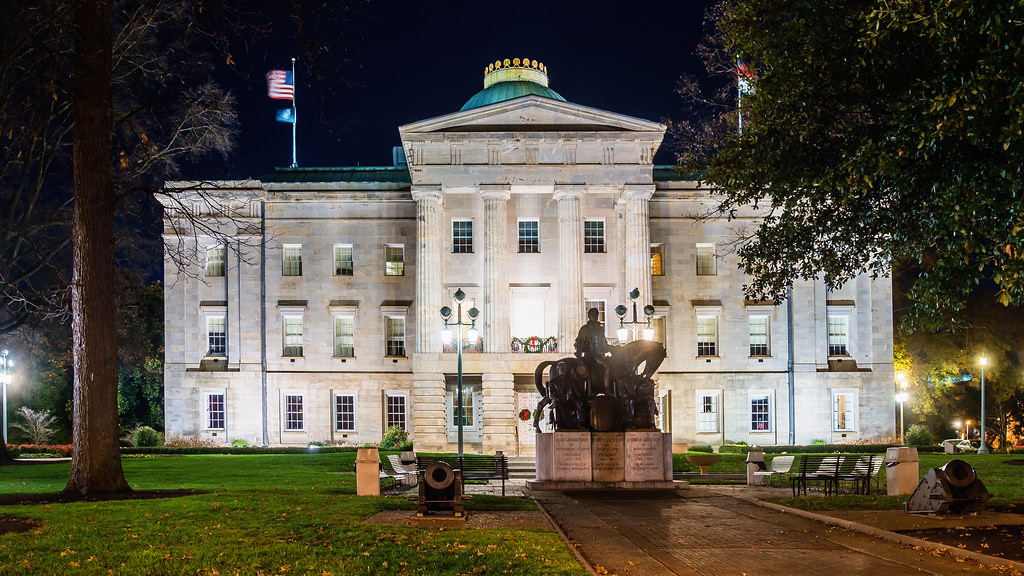Washington State provided a nice example of presidential layering down to a county, a community and ultimately to a body of water. I couldn’t find any better example. However, I wondered whether I might be able to do something similar on a different tack. Many eastern states reflected another set of leaders, the noble men and women who ruled European homelands as their North American colonies arose.
Potentially, it might be an easier investigation too. Several states gained their names from nobility. These included Delaware (Thomas West, 3rd Baron De La Warr), Georgia (King George II), Louisiana (Louis XIV of France), Maryland (Queen Henrietta Maria, wife of King Charles I), New York (Duke of York, later King James II of England), Virginia (Elizabeth I of England, the Virgin Queen) and West Virginia (also Elizabeth I). I checked them all. The best example I found came from the Carolinas, from North Carolina specifically (map).
North Carolina

Both North and South Carolina derived their names from the same monarch, King Charles II. I consulted one of my favorite sources, the Online Etymology Dictionary. It explained that the name Charles began as Karl in Middle High German, meaning “man” or “husband.” In Medieval Latin this became Carolus, then Charles in French and then the English adopted it. Early explorers and settlers used the Medieval Latin variant when naming the Carolina colonies.
Mecklenburg County

Naturally, noble names extended downward to the county level although not necessarily in recognition of a reigning monarch. North Carolina’s Mecklenburg County (map) offered an excellent example. This county grew in importance in recent decades as a financial and banking center, recently achieving a population of more than a million residents. However it began humbly on the Piedmont frontier, carved from an earlier existing county. Mecklenburg recognized Charlotte of Mecklenburg-Strelitz who married King George III just before the county formed.
Charlotte seemed an odd choice as a wife for one of the most powerful men in the world. She came from a minor German duchy far removed from Europe’s powerful families and she spoke no English. Royal Central [link no loner works] explained,
“As a young woman, Charlotte received a very meager education, and what few opinions she had, she kept to herself. This quality of hers appealed to the young King George III, who desired a wife who had no experience of power politics and party intrigue.”
George III married his German fiancée site unseen. She undertook the journey from her home duchy and the marriage took place six hours after she arrived at St. James’s Palace in London. That’s how they did things in royal circles back in the day with those arranged marriages. It was more important for George to start expanding his royal lineage than worry about niceties like getting to know his prospective bride. Apparently they got to know each other pretty well because Charlotte bore fifteen little princes and princesses.
Charlotte

I cheated a little. I already knew that the city of Charlotte (map) in Mecklenburg County also got its name from Charlotte of Mecklenburg-Strelitz. That little peculiarity served as a minor footnote in an earlier Twelve Mile Circle article, Ten Seats in North Carolina. A better example would avoid repetition, however I couldn’t find any of those. Maybe someone in the audience can enlighten us with a different set of layering.
It surprised me that the places named Charlotte and Mecklenburg survived the Revolutionary War. The county formed in 1762 and the city in 1768, just a few years before the United States declared its independence. The Revolutionaries hated King George III and everything he represented. They had a perfect opportunity to dump his wife’s name and yet it persisted.
Albemarle Road
Then I started stretching the layers, maybe past their natural breaking points on North Carolina’s Highway 27. So, NC 27 “has had a tumultuous history through Charlotte. It has always served as a major east–west route through the city, but it has been rerouted numerous times on different city streets as traffic patterns changed.” Since 1924, the route included Albemarle Road. Various Dukes and Earls of Albemarle existed as a peerage of England and the name reflected in several places on the colonial landscape.
The most significant usage in North Carolina happened on the body of water separating its string of barrier islands from the mainland. It became Albemarle Sound. This recognized George Monck, 1st Duke of Albemarle. I found no evidence although I suspected Albemarle Road derived its name from Albemarle Sound. Even if it didn’t it must have come somehow from the extended family of Albemarle nobility. An odd name like Albemarle wouldn’t crop up completely by chance.
Albemarle Road Park & Recreation Center
I carried the layering ever more tenuously to the Albemarle Road Playground. It seemed to be a nice place. The city of Charlotte described it as 21 acres of “picnic shelter, playground, recreation center and multi-purpose field.” However, I noticed it didn’t abut Albemarle Road. On the other hand it did seem contiguous with Albemarle Road Elementary School and Albemarle Road Middle School. They sat at the end of an access road that did in fact connect to Albemarle Road.
Thus, North Carolina contained a county of Mecklenburg with a city of Charlotte bisected by Albemarle Road featuring an Albemarle School complex and a playground.
Can anyone do better? I didn’t check Canadian provinces. That could be a possibility.

Leave a Reply